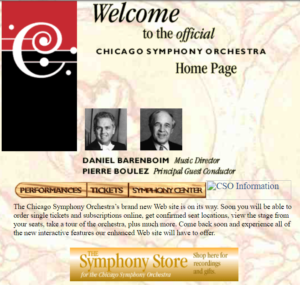I wrote on Facebook awhile ago that there ought to be a book on the history of American orchestras from the 1980s on. Or the 70s, maybe.
I got that idea from comments on a good-natured post I did, citing Will Roseliep’s writing about the first websites the Big Five ever created. Period pieces, all of them, As of course they’d be, since they date from the early days of the web.
In the comments on Facebook, people active in orchestra affairs back then reminisced about creating those websites. How hard it was to convince orchestra boards that websites were a good idea! Let alone necessary.
It was wonderful to read all that. Gave me so much sympathy and admiration for the people involved.
Unpublished history…
But then I thought (and wrote) that this history most likely wasn’t published anywhere. And that there should be a book about all the changes orchestras went through in the last few decades. As they went through a huge evolution, adapting to the digital revolution, falling ticket sales, changes in our larger culture, and of course growing financial distress. And, coming up in the past few years, the drive for diversity, and also #metoo, which hit at least a few orchestras.
(Cleveland was especially stricken. But when, last year, they finally faced up to it, they dealt with it beautifully, commissioning an investigation by an independent law firm, which concluded that two principal players had harassed or abused women, and also that the orchestra should have known this earlier, and should have acted on it. A criticism the orchestra was willing to put online.)
I’ll do some other posts about what could be in this book. Much of what I’ll suggest will be things that aren’t usually disclosed. Stories that for the most part would normally not be revealed. But which are crucial — or at least illustrative — for this history.
Among these would be the discovery orchestras made early in the 2000s (I’m not sure this has ever been revealed in public), that for years they’d been running structural deficits. Spending more than they were taking in, not just in occasional years, but consistently.
I happened to be at a meeting where this was first discussed, under the leadership of the then executive director of one of the country’s top orchestras. (Because I’ve learned about many of these things in private, I’ll often not say which orchestras were involved. Though in the book all would have to be revealed.)
Why they didn’t notice
Why didn’t orchestras notice their ongoing drain of money? Because, it was said at the time. that in good economic years they did very well. So well that they didn’t notice that the money they lost in bad years was more than what they made when the economy was good.
We might well ask why orchestras were blind enough to fall into that trap. But, whatever the reason, ongoing structural deficits do a lot to explain why, a decade later, so many orchestras had big financial crises.
That’s a big story that should be in this book.
And here’s a smaller one…
…about adapting to current culture:
During the ’90s, the Columbus (OH) Symphony discovered that the demographics of its audience were similar to the demographics of Harley riders.
So — as a way to be contemporary — they built their season brochure around the power and thrust of Harleys. Saying that the power of symphonic music was like the power of a motorcycle.
But then came some problems. I was told that one board member expressed astonishment (in more or less the following words, and in very much their tone): “One would think the orchestra wished to appeal to those who do not go its performances.”
Well, exactly! But we should be sympathetic, and see how this marketing campaign took some of the orchestra’s stakeholders out of their comfort zone. Much as the idea of websites did.
That was told to me as ( think) a smaller problem. Here’s a bigger one. The orchestra’s main corporate funder was Honda. Which makes motorcycles, which compete with Harleys.
When the Harley campaign was unleashed, Honda wasn’t happy. Which the orchestra’s management, in its naiveté, hadn’t anticipated.
I don’t tell this story to make fun of the orchestra. Instead I think it shows something important — that the journey into current culture can be new for these institutions, and that missteps along the way can be likely.
Honda, by the way, is still listed as a corporate donor in the symphony’s last annual report, though it isn’t at the top of the list.


And by the way, the design of the site you illustrate your excellent post with is absolutely terrible! Of course, that was par for the course in the early web. One assumes that by now the Chicago people have hired a much better designer.
Certainly is terrible, Jon. And we can forgive them, because as you say, their first website. Before the world had figured much out about web design.
I’ll put a caption on it, so everyone will know it’s what you so rightly say it is.
Your metoo comments were out of place and unwelcome to read.
Why?